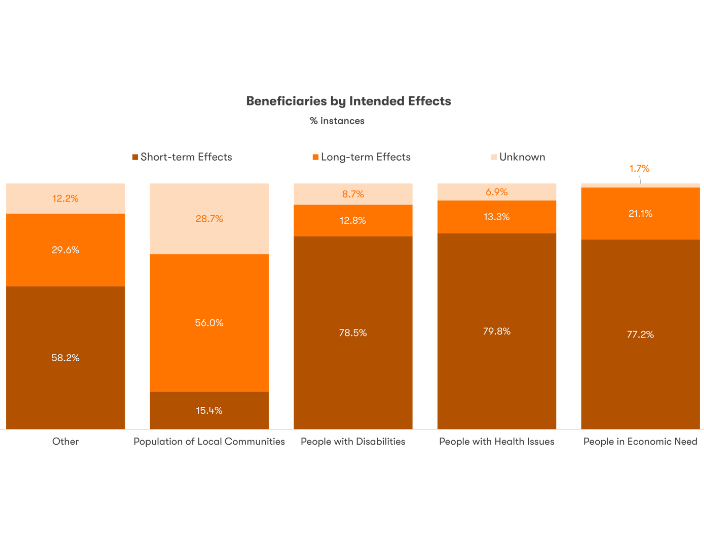Trends in Beneficiary Groups in Serbia – 2018-2022

Graph 1: Trends in Key Final Beneficiary Groups Impacted by Giving in Serbia – 2018 - 2022 (% of instances)
Beneficiary Groups Receiving Support from Domestic Giving in 2022
Since 2020, population of local communities received support most frequently when compared to other beneficiary groups. However, in 2022 this trend was changed, due to the drop in the percentage of giving intended for local communities. Instead, people with health issues became the most frequently supported group. Specifically, 20.3% of all instances and 58.5% of the total donated amount was intended for people with health issues. These instances most often included actions for raising funds intended for providing medical treatments.
Other key beneficiary groups (population of local communities, people in economic need, and people with disabilities) had a somewhat smaller percentage of donation instances. In terms of the total recorded amount, people in economic need were the second most supported beneficiary – 13.8% of the total amount. A significant part of this amount can be attributed to the collected amount in 2022 by the Srbi za Srbe humanitarian organization, which raised around 3 million euros in donations for the support of socially disadvantaged families.
Regarding other beneficiary groups, which generally have less recorded instances, most of the giving was directed to single parents (4.6%), people living in other countries (3.6%), talented children and youth (3.1%) and children without parental care (3%).

Graph 2: Breakdown of Final Beneficiary Groups Impacted by Giving in Serbia in 2022
How Beneficiary Groups are Supported by Various Types of Donors
Citizens through mass individual giving were the main donor types in giving for people with health issues, people with disabilities and people in economic need. On the other hand, the primary source of giving for the population of local communities was the corporate sector.
Donations by citizens through mass individual giving were most frequently directed for people with health issues, and these mainly included funding for medical treatment. For the support of people in economic need, citizens were most active in actions which raised funds for humanitarian support and the distribution of supplies and consumables.
For the support of local communities, corporate sector was most active in donations of equipment such as IT equipment for schools, medical equipment intended for health institutions and other.

Graph 3: Flow of Giving from Type of Donor to Type of Key Final Beneficiary Groups – 2022 (% of instances)
Intended Effects of Giving for Key Final Beneficiary Groups
Donations with long-term effects were given in 56% of all giving to local communities. On the other hand, for the support of other key beneficiary groups (people with disabilities, people with health issues, and people in economic need) short-term giving, such as donations which were used to address immediate needs and provide humanitarian assistance or other forms of support that temporarily address a social issue, were the primary form of giving.

Graph 4: intended Effects of Giving by Key Final Beneficiary Group – 2022 (% of instances)
Examples of Giving
Giving to the local community
Delhaize Serbia donated 4,260 euros to Niš Local Foundation in 2022. The funds are aimed at community welfare initiated through Trag Foundation's program "Foundation of our neighborhood – community gives answers!". Another example of giving to the local community comes from Slobodan Vasić, a Požarevac radio journalist, who received the VIRTUS Special Award for raising funds for medical treatments and renovating homes for families in need. His efforts raised 31,500 euros for J.M.'s treatment and supported vulnerable families.
Walk of solidarity
Pedagogue Nenad Popović walked 1300 kilometers to help a family in Žabalj village without electricity or water. Citizens' support raised 6,300 euros during his 30-day journey, aiming to build a new house for the family through the Just Giving platform.
The Annual report Giving Serbia 2022 was supported by the C. S. Mott Foundation and the Rockefeller Brothers Fund. The views expressed on this web page do not necessarily reflect the views of the C. S . Mott Foundation and the Rockefeller Brothers Fund and their partners.


Leave a comment